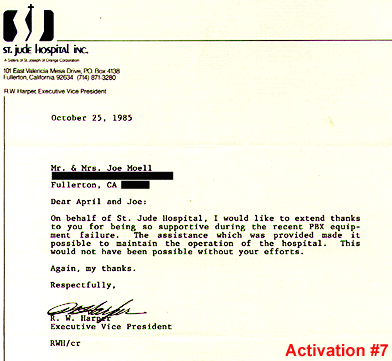 Activation #8
Activation #8Incident: Severed Trunk Lines
Date: February 3, 1987
What Happened: All external communications, including phone lines, FAX lines, paramedic communications and pay phones failed at St. Jude Hospital and Rehabilitation Center in Fullerton just before 2 PM, when workmen widening the street in front of the 6-floor hospital cut the main phone cables into the facility.
HDSCS Response: HDSCS leader April Moell, who was St. Jude's Director of Occupational Therapy at the time, was alerted by the switchboard operators. With her ham radio, she reached Dave Browers WB6RVM, who contacted the phone company for repairs and activated Ted Kramer NB6N to serve as the outside base station contact. Gary Holoubek WB6GCT was first to join WA6OPS at the hospital for additional support and was assigned to the Labor and Delivery area. Richard Gehle WD6Y soon arrived from work and was placed in the Emergency Department. John Gillette N6NVR was sent to the Intensive Care Unit. Relief operators arriving later included Chappie Chapman KG6NW, Larry Zysman N6BNM, Carole Mulligan KA6JMW, Bob Hastings K6PHE and Gracie Hastings N6FSL.
The hams passed messages an internal simplex radio net and an external net on the Anaheim Amateur Radio Association repeater. As radio traffic increased, Joe Moell KØOV set up a two-meter base station at the hospital switchboard to place high-priority outgoing calls through an autopatch (radio-to-telephone connection) in the K6QEH repeater at nearby Hughes Aircraft Company. Most of the autopatch calls went from hospital nurses to doctors at their offices, reporting patient status and to getting orders for medication and treatment. External calls were also made via phones at Hughes by Jim Grove N6AXN. Some lifesaving messages were passed during the 3-1/2 hour outage, including a call to Red Cross to get blood products for an emergency brain surgery.
Lessons Learned: When a phone outage begins, there's no way to know how long it will last. That's why HDSCS tries to get operators into the facility as soon as possible, even if they must leave and be replaced within a few hours. Average duration of an outage has been just under four hours. Our longest was Activation #13 on September 27, 1989, when internal and external phones at St. Jude Hospital were out for 23 hours due to a power supply failure in the switching system. It took that much time for telephone workers from as far away as Colorado to arrive and install parts from as far away as Arizona. All the while, hams kept the messages going by using simplex, local repeaters, and a portable crossband repeater in the hospital parking lot. A total of 35 HDSCS members participated over the 23 hours. Afterwards, one Intensive Care nurse stated, "The hams were great! They knew just what to do."
The evening hours are especially busy in some hospital units, such as Labor/Delivery and the Emergency Department. HDSCS handled over 20 emergency messages in 2-1/2 hours during a phone failure on May 22, 1996 (Activation #52). We were activated at 5:45 PM and three responders were there by 5:59 PM. Several women were in active labor on the third floor and the Emergency Department was hectic. Messages included nurses' requests for doctor's orders for new patients and a "stat" call-in of a physician to perform an emergency C-section. To facilitate handling these messages, HDSCS used several simultaneous radio paths -- two phone patches on two separate repeaters plus message relays on another repeater and simplex. Eleven HDSCS members were involved.
Lessons Learned: Our response time was excellent because several members were on the way home from work with equipment "go kits" in their vehicles at the time of the activation. Our motto on equipment preparedness is "Don't leave home without it."
What Happened: At 4:48 AM, an earthquake struck near the desert town of
Landers, measuring 7.3 on the Richter scale and strongly shaking most of
southern California for about 45 seconds. Then at 8:05 AM, a 6.4 magnitude
temblor (technically an aftershock) occurred on a conjugate fault line 25 miles
away from Landers, next to the mountain resort community of Big Bear Lake. The
quakes occurred in the middle of Field Day, an annual Amateur Radio emergency
preparedness exercise wherein groups of ham operators set up stations in parks,
campgrounds and other outdoor sites and then compete to see which groups can
make the most contacts on the air.
HDSCS Response: Immediately after the Landers quake, 32 HDSCS members
left their homes and Field Day sites and proceeded to their assigned hospitals
to check for damage and assess communications needs. Through the two-meter
HDSCS net, they coordinated their movements such that all 34 hospitals were
physically checked within three hours. Most facilities were reached within 90
minutes of the first quake. Three of the hospitals experienced partial or
complete telephone outages. Nine hospitals had power failures requiring use of
their emergency generators.
Upon arriving at Buena Park Doctors Hospital, Gary Holoubek WB6GCT (pictured at right) found it in
total darkness. The emergency generator had started when Edison power failed during
the first quake. Edison power had come back, then there was an aftershock and it went out again. This time, the generator failed to come on line.
Employees were scurrying, trying to find flashlights. Fortunately, Gary had
brought some. The hospital phone system had also gone down. Gary put out a
call asking HDSCS members at base stations to contact Edison Company for help,
but phone circuits were overloaded. Joe Moell KØOV called on the Orange County
RACES repeater to request the county's assistance in contacting Edison. Before
the Emergency Operations Center could respond, RACES member Harvey Packard KM6BV spotted an Edison
truck in his neighborhood, called on the HDSCS net frequency and got the Edison
worker to radio his dispatcher and ask for an emergency response to the
hospital. HDSCS continued to provide communications support until phones and
power returned to normal.
Lessons Learned: Here was proof positive of the importance of our
"bottom-up" automatic Core Team response. It's vital to check every supported facility
as soon as possible after an earthquake, without waiting to be activated by
government officials. An in-person visit to each hospital is far better than a
phone call, because hospitals want to keep their lines clear and the
switchboard operator may not yet know the full status of the facility. Hams
also should keep checking to insure that communications don't deteriorate due
to overloaded lines in the area. We had learned this following the 5.9
magnitude Whittier Narrows earthquake on October 1, 1987 (Activation #9), when
the phones at St. Jude Hospital in Fullerton worked initially, but 20 minutes
later they failed and were intermittent for some time.
HDSCS members are trained to check in on their main net frequency immediately
after they feel the ground shake. After the 6.7 magnitude Northridge
Earthquake on January 17, 1994 at 4:30 AM (Activation #28), a total of 41 HDSCS
responders were checked into the net and setting out for hospitals within
minutes after the shaking stopped. Status of all Orange County hospitals was
determined and reported within 90 minutes. Response time was similar following the Hector Mine earthquake in October 1999.
What Happened: At midday, Gas Company workers using a backhoe
accidentally cut through telephone and data cables between St. Jude Medical
Center and the Fullerton Internal Medicine Clinic two blocks away.
HDSCS Response: HDSCS members were activated and responded to both
sites. They remained on station for five and a half hours to link nursing
staff at the hospital to physicians at the clinic for many critical patient
messages. Bob Reitzel KD6DA and Joe Moell KØOV were stationed at the clinic next to the
intercom, where they could easily contact the doctors when messages came in.
At the hospital were Christie Edinger KØIU and John North K6GMY at the
switchboard, Larry McDonald N6ZMB and Dennis Bennorth WD6BIP in the Emergency
Department, and Jean Creason KC6PPY and Gary Holoubek WB6GCT in the Intensive
Care Unit. Base Stations and Net Controls were April Moell WA6OPS and Ted
Kramer NB6N. Although the cut cables weren't repaired until 7 PM, the ham
operators deactivated at 5:30 when the doctors left the clinic for their
hospital rounds.
Lessons Learned: It seems as if there is always construction going on
at hospitals or in the streets nearby. So there is always the possibility of
accidental cable cuts. Since most construction occurs during the daytime, when
hospitals are busy and physicians are at their offices, a rapid response from ham radio operators is vital.
HDSCS has individual and redundant alerting plans in place with each hospital,
so we have been able to get on scene quickly. Some of our other severed-trunk
responses have included South Coast Medical Center (Activation #27), Chapman
General Hospital (#31 and #34), and Tustin Hospital (#72).
Electrical power disruptions at construction sites can also cause phone systems to drop
out and require service. An example is Activation #40 in October 1994, when a
forklift came in contact with a power line near Chapman General Hospital and
the phones went down. Power failures or surges have also caused phone outages
at Tustin Hospital (Activation #38), Chapman General Hospital (#40), Hoag
Memorial Hospital (#57), Martin Luther Hospital (#63), Coastal Communities
Hospital (#65), and West Anaheim Medical Center (#68).
What Happened: A computer malfunction at a Pacific Bell call processing center in
the city of Cypress disrupted service to 71,000 phones in north Orange County
homes and business, beginning about 8 AM. Emergency 9-1-1 lines were affected
as were exchanges in cities of Cypress, Buena Park, Anaheim, El Toro, and Seal
Beach.
HDSCS Response: After repeated attempts by HDSCS to contact West
Anaheim Medical Center, Bob Reitzel KD6DA was sent to check on the 243-bed
facility. Internal phones were OK, but doctors and other patient care
personnel were swamping the switchboard because they couldn't make outside
calls. One medical unit was using a cell phone for this purpose, but it did
not have consistent service. At this point, Mike Scofield N6OKG arrived. He
and KD6DA began handling messages including requests for additional physicians,
surgical supplies for special procedures upcoming, and transportation for
discharged patients. The activation continued until full phone service was
restored at 4 PM. Operators arriving later for additional communications
support included Norm Royce KD6IFF, Jean Creason KC6PPY and Jim Black N6VNU.
Base stations providing message handling to the outside were operated by Joe
and April Moell, KØOV and WA6OPS. The outage and HDSCS response were covered
by the Los Angeles Times, which quoted KD6DA as saying, "This is our hobby --
helping out hospitals when they need our assistance."
What Happened: A fast-moving wildfire, pushed by winds of up to 70 MPH,
raced down Laguna Canyon toward the sea. It blackened wilderness areas and
then consumed neighborhoods in the Canyon Acres, Mystic Hills, and Emerald
Bay areas. A total of 366 homes and 17,000 acres of terrain burned.
HDSCS Response: At 3 PM, April Moell was called by the Emergency
Department Supervisor at Saddleback Hospital in Laguna Hills. External phone service was
intermittent there and the caller had heard of problems at other hospitals in
the area. HDSCS activated immediately and sent operators to that facility. At
the same time, a Core Team response of operators was made to three other hospitals in the
affected area: Mission Regional Hospital in Mission Viejo, South Coast Medical
Center in Laguna Beach and Samaritan Hospital in San Clemente.
Upon arrival at Mission Hospital, operators Heiko and
Patti Peschel, now AD6OI and AD6OH, found out that the HEAR/ReddiNet*
equipment was not functioning there and that phone circuits were overloaded.
They provided a vital communcations backup link as Orange County Emergency
Medical Services activated its disaster plan.
Through the evening and into the night, the hams relayed out many calls for
staff members and physicians. They provided communications from hospital to
hospital for relocation of patients and for obtaining needed supplies such as
linens. They connected hospitals to the Orange County Health Department and
linked one hospital's House Supervisor to her counterpart at a facility in San
Diego County. Most operators were able to stay in place for the duration, but a few
relief operators had to be sent in. Thanks to our ID procedures, they all got
through the roadblocks.
After midnight, crews began getting the fire under control and the phone
overload problem diminished. Communicators from three of the hospitals were
released, but the hospital in Laguna Beach, closest to the fire line, asked its
operator to stay on overnight. HDSCS maintained an outside base station to
support that operator, who napped periodically on a gurney with his radio next
to his ear. Fortunately, winds did not come up in the morning, allowing
firefighters to contain the blaze.
Lessons Learned: In mid-afternoon with fire danger increasing, local
businesses shutting down and evacuations underway, the streets were becoming
overcrowded and some would soon be closed. Thus it was a wise decision to
activate to all four area hospitals before road closures made it time-consuming
or impossible to get there.
In addition to providing backup medical communications, HDSCS communicators
were praised by the staffs for keeping them informed of the fire situation in
their vicinity and at other hospitals. Click to view two letters of commendation from this activation.
*HEAR and ReddiNet® are commercial VHF voice and Internet/satellite digital inter-hospital communications systems provided by Healthcare Association of Southern California and maintained by the Communications Department of the County of Orange.
Activation #43
What Happened: A series of rainstorms caused runoff to cascade down Laguna
Canyon, destroying businesses and beaches in the city of Laguna Beach. At the
height of one storm, a telephone exchange office flooded, cutting off several
prefixes from the network. South Coast Medical Center, located on the side of
a hill next to Pacific Coast Highway, lost all external communications
including paging to physicians. Cell phones were nearly useless, because that
system was damaged and overloaded. Calls dropped within a few seconds.
HDSCS Response: One of these aborted cell calls was to HDSCS. All that the
HDSCS operator heard was "South Coast," which was enough to set our response in
motion. Within 30 minutes, the first member arrived and began communications
from the Emergency Department of the 208-bed facility. For the next five hours,
the HDSCS net handled messages vital for patient care including calls to
outside physicians, hospital staff, and the police. A total of 13 hams took
part. Afterwards, South Coast's Chief of Facilities Chuck
Coryell said, "The ham communications were invaluable. No amount of money
could have bought this kind of service."
Lessons Learned: HDSCS goes on high alert whenever Orange County experiences exceptional
weather, including heavy rains, high winds, or one of our rare thunderstorms.
This significantly improves our response time when weather causes communications failures.
In the photos: Top to bottom, Gary Holoubek WB6GCT, Bob Reitzel KD6DA, Mike Scofield N6OKG, and Alan Marcum WB6RQM. These Amateur Radio operators served in many drills and communications emergencies during the early years of HDSCS.
Back to the HDSCS home page
This page updated 1 September 2016
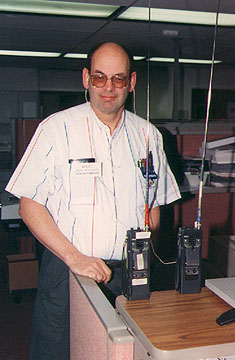 Activation #18
Activation #18
Incident: Landers and Big Bear Earthquakes
Date: June 28, 1992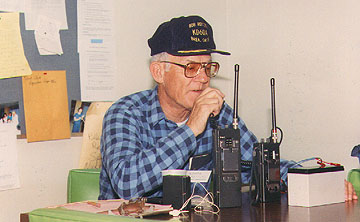 Activation #21
Activation #21
Incident: Severed Lines Between Facilities
Date: December 8, 1992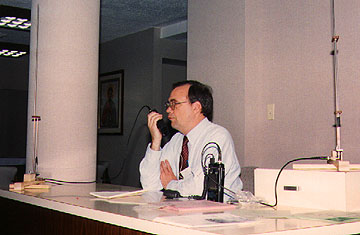 Activation #25
Activation #25
Incident: Area-wide phone outage
Date: September 15, 1993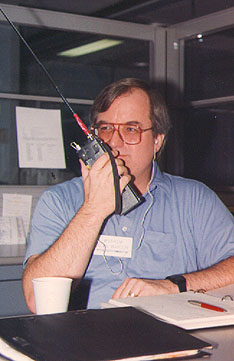 Activation #26
Activation #26
Incident: Laguna Firestorm
Date: October 27, 1993
Incident: Laguna Flood
Date: January 4, 1995